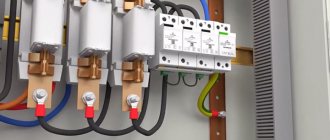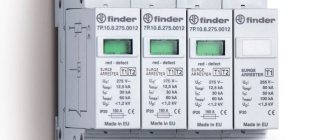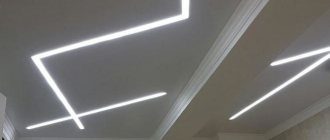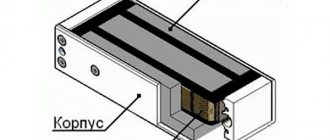Often the cause of damage to electrical wiring, household appliances and equipment is a sharp surge in voltage in the network. The simplest and most reliable way to protect against this type of event is to install a special surge protector for a private home. Let's look at what such a device is, how it works and what its purpose is, what types of it exist, why power surges can occur in the network, how to choose the right device for your own home, and what are the main features of its installation.
SPD provides complete protection of electrical appliances in a private home from overvoltage Source ezetek.ru
SPD - what is it, principle of operation, purpose
Despite the assurances of electricity suppliers about the reliability and stability of the characteristics of the supplied electric current, voltage surges of tens or even hundreds of volts are a fairly common occurrence. The consequences can be very different - from blackout of the home electrical network to damage to expensive equipment and fire.
The only sure way to protect your home from this kind of negative processes is to install a surge protection device, otherwise called an SPD, at the entrance to the home electrical network. The principle of operation of the device is based on reducing the magnitude of the pulse voltage to an acceptable value - the one for which the safe operation of electrical appliances installed in the house is designed. The resulting excess current simply goes into the ground through the ground loop. Some models additionally de-energize the entire internal network.
The protection device diverts the overvoltage current into the ground loop Source sk-vayar.ru
Existing models have different operating lives - some need to be replaced immediately after the first operation, others can be restarted up to 10-20 times. In this case, the operability of the device is externally determined by a special indication. Green means it is suitable for further use, red means it needs to be replaced.
Surge protection devices are divided into 3 classes:
- 1st class is installed on the main input panel. It is he who takes on the main burden.
- 2nd class is mounted in the local switchboard. Takes over the rest of the momentum.
- Class 3 is located in the circuit directly in front of specific equipment.
At the same time, according to the requirements, the installation of SPDs of different classes must be carried out so that, according to the electrical diagram, a minimum distance between them is maintained - 10 m along the length of the wiring.
Important! A voltage relay protects the home's electrical network from small surges. However, it is not capable of protecting equipment from impulses of several hundred or even thousands of volts, which occurs during a lightning discharge. Only an SPD can cope with such a task.
Schematic design and operating principle of a disposable SPD Source zandz.com
Operating principle of the device
The operating principle of the protective device is quite simple. Typically, a surge protector can eliminate an overvoltage instantly. This is a simple voltage tapping circuit. For example, if the voltage is normal, then the resistance of the varistor will be determined by megaohms. If an overvoltage appears on the line, then the varistor moves to the cable category. An electric current passes through the conductor and flows to ground.
How does a voltage limiter work?
For your information! The operating principle of SPDs is classified into two categories: valve/spark arresters. They are usually used for high voltage networks, like protective devices with varistors.
When the action of a lightning discharge during overvoltage is detected in the arresters, then this can break through the air passage in the jumper that connects the phases to the ground loop. A high voltage pulse hits the ground. In the case of valve-type arresters, the reduction of the high-voltage pulse in the circuit with the spark gap occurs through a resistor.
SPDs in gas-filled arresters are suitable for buildings where an external lightning protection system or electricity supply occurs through the air due to special lines.
Equipment with a varistor is connected in parallel with the protected device. In the absence of pulse voltage, the current flowing through the varistor is almost zero. However, when an overvoltage occurs, the resistance of the equipment drops sharply, it allows current to pass, dissipating the absorbed energy, causing the voltage to drop to its nominal value. Thus the varistor returns to non-conducting mode.
The SPD has built-in thermal protection, which prevents burnout at the end of its service life. However, over time, the device breaks down and the voltage limiter needs to be replaced. The indicator itself informs about problems.
You might be interested in: Definition and connection of SPDs
Causes of overvoltage
A pulsed voltage drop in a network is a lightning-fast increase in voltage from several tens to thousands of volts. Such an event can last only a few milliseconds. However, this is quite enough for all connected devices and electrical wiring to burn out and with a high probability lead to a fire.
There can be several reasons for overvoltage:
- Lightning strike. It is the most dangerous in terms of consequences, since a voltage surge can reach several kilovolts. In this case, lightning does not have to strike exactly the phase conductor, but it is enough to strike a few meters from it for a powerful impulse to arise in the conductor. The only way to prevent such a natural factor is a surge protection device installed at the entrance to the house.
- Damage to the neutral wire. An event can occur due to various reasons - burnout of a contact, breakage of a wire on a power line due to wind or a tree falling, etc. In any case, instead of the usual 220 V, the consumer will receive 380 volts or more with all the ensuing consequences.
See also: Catalog of companies that specialize in electrical work of any complexity
- Connection errors after electrical repair work.
- The occurrence of excess load due to the connection of powerful equipment, the simultaneous inclusion of many consumers or welding work in adjacent areas.
- Incorrect connection of contacts in the electrical panel.
The occurrence of at least one of the above events will inevitably lead to breakdown of household appliances or fire of surrounding materials. Another exactly opposite situation is a sudden drop in voltage. Equipment, especially those equipped with automation, suffers from this to a greater extent.
For example, modern boilers, when such a failure occurs, immediately stop and display an error. Therefore, to eliminate such consequences, the unit is connected through a current stabilizer, which detects changes in time and equalizes the voltage to the nominal value.
To prevent malfunctions, it is better to connect the heating boiler through a voltage stabilizer Source gradusplus.com
On a note! For home equipment operating from a 220 V network, protection is required not only from large overvoltages, but also from minor ones. Therefore, it is advisable to equip the electrical circuit with various surge protectors, stabilizers and voltage relays; this is especially true for equipment that is sensitive to the slightest changes. However, they alone will not be enough - without an SPD, if a powerful impulse occurs, they will all burn out along with the equipment.
Main types
The type of network interference includes both overvoltage associated with a phase imbalance of a longer duration, and overvoltage caused by a lightning discharge.
Important! When a pulse overvoltage occurs, this indicates the occurrence of a short-term high voltage between phases or phase and ground with a duration, usually up to 1 ms.
A lightning discharge is a powerful impulse overvoltage. It occurs when lightning strikes an electrical system. If the distance from a lightning strike reaches up to 1 km, then such a pulse overvoltage can cause failure of electrical equipment. A direct impact produces an instantaneous pulse current of up to 100 kA/s. Typically, the discharge duration is up to 1 mS.
What types of voltage limiter are divided into?
If there is a lightning rod system, the discharge pulse can be evenly distributed between the lightning rod, power supply, communication line, and household communications. This process depends on the design of the structure itself, the communication system, and the laying of the line.
Switching in the power grid causes pulsed power overvoltage. For example, if you disconnect an isolation transformer that has a power of 1 kVA 220/220 V from the network, then all the energy is released into the load in the form of a high-voltage pulse with a voltage of up to 2 kV.
The power of any transformer in the power grid is much greater, and accordingly, the emissions will be more powerful. In addition, switching occurs against the background of an arc, which becomes a source of radio frequency interference.
Note! The electrostatic charge that accumulates during the operation of technological equipment, although it has little energy, is discharged at an unpredictable moment.
The amplitude and type of overvoltage pulse vary not so much from the source of interference, but from the parameters of the network itself. No two cases of surge overvoltage are the same, but for the production and testing of protection devices there is a standard for the parameters of current, shape and voltage, overvoltage in different cases.
For example, for the expected current from a lightning discharge, a current pulse of 10/350 μs is taken, and for the indirect effects of lightning and various switching overvoltages, a current pulse with characteristics of 8/20 μs is taken. When comparing two devices with a high pulse discharge current of 20 kA at 10/350 μs and 20 kA at a pulse of 8/20 μs, the real power of the first will be 20 times greater.
Switching protective devices
Such limiters have other names, for example, spark gap. The operating principle of this device is based on the use of the spark gap phenomenon. The design has an air gap in the jumper, which serves to connect power lines to the ground loop. The circuit in the jumper is open at rated voltage.
Switching protective devices are also called spark gaps
If a lightning discharge occurs due to overvoltage in the power line, an air gap breakdown will occur, the circuit between the phase and the ground will be closed, and the high voltage pulse will be directly grounded. The design of the valve arrester in a circuit with a spark gap is like a resistor on which high voltage pulses are suppressed. As a rule, arresters are used in high-voltage networks.
Limiters (SPD)
Thanks to new devices, it was possible to replace the more outdated huge models. To determine the performance of the limiter, you should carefully familiarize yourself with the characteristics of the nonlinear resistor, since the arrester operates on the basis of the current-voltage function.
In the production of varistors, zinc oxide material is usually used. The formation of the component occurs due to the combination of the solution with other substances. The result is a pn junction with current-voltage characteristics. If the voltage in the network corresponds to the nominal parameters, then the current in the varistor circuit is zero. When an overvoltage occurs in a pn junction, the current conductivity increases. Because of this, the voltage value drops to the nominal value.
You might be interested in The simplest asynchronous current generator
Characteristics of the network surge suppressor
Note! After standardizing the network parameters, the varistor returns to non-conducting mode without affecting the operation of the device.
Combined
Combined devices operate under normal operating conditions with unfavorable voltages from 0.94 to 1.96 values. These models are equipped with a resistor. In action, the combined device not only grounds the voltage, but also simultaneously stabilizes the value in the structure itself.
Combined surge arrester
Classes
Such devices are divided into several categories:
- I prevents direct exposure to lightning strikes. As a rule, such devices have input distribution equipment (ADS). It is usually used for administrative and industrial buildings and residential apartment buildings;
- II helps to protect the distribution network from overvoltages that may be caused by switching or secondary protection functions. This is done to prevent exposure to a strong lightning strike. As a rule, they are installed and connected directly to the network in the panel;
- III carefully protects equipment from voltage surges that may result from residual surges and asymmetrical voltage distribution between phase and neutral lines. The operating principle of such a device is to operate in high-frequency interference filter mode. They are connected and installed in private houses or apartments. Particularly popular is the product made in the form of a module. This device can be easily installed on a DIN rail.
What classes are SPDs divided into?
Varieties
In order to protect the home electrical network from any kind of overvoltage, including pulsed, the following types of devices are used:
- SPD.
The device primarily protects against high voltage surges, such as, for example, during a lightning strike. There are the following installation options:
- Inside the input panel. Installed together with lightning protection of the house. Is the most reliable. If lightning strikes the house, the device will work like an automatic machine and protect all the equipment in the house. An option without a lightning rod is also allowed. But then you will need to install several different types of SPDs - one on a power line support, another on a pole next to the house, and another one on the panel of the house itself.
Installation of an SPD inside the input panel of a private house Source art-liga.rf
Purpose of surge protection device
Conventional automatic machines, which are widely used at various sites, will protect your network from possible overloads. If you install a voltage control relay, you can protect yourself from short-term minor increases in voltage in the network, for example, from 220 to 290 V.
Now imagine if a pulse occurs, the voltage value of which reaches 1 kV or more. Traditional protection devices will simply burn out before they have time to work, along with everything that is plugged into the sockets at that moment. It is from these sudden voltage surges that the SPD is designed to protect.
I want to immediately explain that the device in question is in no way an alternative to voltage relays or other equipment installed in homes to protect the electrical network. Please note that surge protectors will not operate if the voltage exceeds only a few tens of volts from the normal value. It should be used in conjunction with other devices.
Rice. 1- Surge arrester
Selection rules
When choosing a surge protection device for a private home, you must be guided by the following criteria:
- Number of phases in the network. The number of input contacts will depend on this.
- A class that specifies a place in an electrical circuit.
- Installation location - outdoors or indoors.
- The degree of accessibility for servicing by a non-professional user.
- Installation method: portable or fixed installation.
- Availability of protection functions - thermal, leakage current, overcurrent.
- Protection from external factors - temperature and humidity.
- Ambient temperature for operation - for outdoor or indoor installation.
- Type of grounding system.
Reference! If the SPD does not exclude the possibility of servicing by an unqualified user, for example, when it is installed in a house panel rather than on a pole, it should not include live parts without a protective sheath that are accessible after removing the parts without using a tool.
Installation features
To install an SPD in a private house, 2 basic conditions must be met:
- Availability of a grounding system. Moreover, the type of device itself will depend on its type.
- The presence of an automatic device that turns off the SPD when triggered to ensure uninterrupted power supply to the house.
In this case, the surge protection device in the electrical circuit of a private house must be installed according to the following scheme:
- An automatic switch is installed at the input to protect the meter and the internal circuit of the panel.
- Between the metering device and the machine there is an SPD with its own protection.
- Next in the diagram is the counter.
Good to know! The most common errors that reduce the functionality of an SPD or make it useless are a poor grounding circuit, the device does not match the type of grounding, and the use of a device of a class that does not correspond to its place in the circuit.
Do you need an SPD for a private home?
The days of fuses and traffic jams are long gone. Today, in the water electrical panels of almost all private houses there are entire protective systems from automatic circuit breakers to RCDs. In case of any overvoltage, short circuit or leakage, the consumer is instantly disconnected from the line. So why add an SPD to this very complex?
The fact is that the high-voltage pulse is very short and ordinary automatic machines and similar protection simply do not have time to react to it. Moreover, these pulses carry enormous energy - the short circuit current with such a pulse can reach many tens of kiloamperes. The same machine will not cope with a similar problem - it will not only not save the consumer, but will also successfully burn out.
Thus, if after the next thunderstorm we do not want to be left without household appliances or even without a roof over our heads (such accidents can start a fire), then we will have to agree that an SPD for a private home is still needed.
Briefly about the main thing
A surge protector protects your home's electrical system from power surges. The resulting large current is discharged into the ground loop without causing harm to home equipment. Depending on their place in the circuit, SPDs are divided into 3 classes.
The most common causes of network overvoltage are:
- Lightning strike.
- Errors made by electricians.
- Damage to the neutral wire.
- Incorrect connections in the electrical panel of the house.
There are 4 main types of household surge protection devices - surge protectors, stabilizers, surge protectors and non-linear current limiters. When choosing an SPD, you must first take into account its technical characteristics. Installation of the device is permissible if two conditions are met - the presence of grounding and its own circuit breaker. In the circuit, the device should be located between the input machine and the meter.











